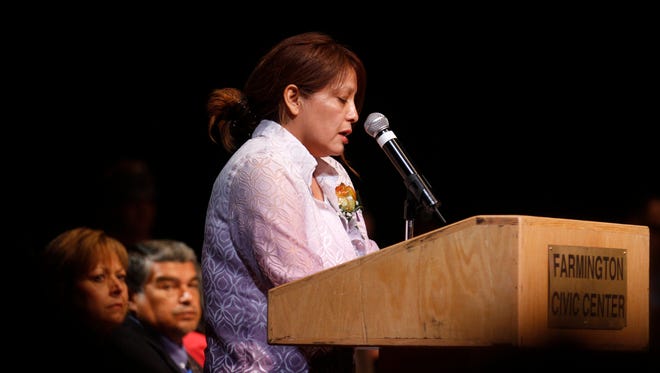Abducted girl’s mother decries slow Amber Alert

FARMINGTON, N.M. — The mother of an 11-year-old girl who was abducted and killed, urged Navajo lawmakers who attended her daughter's funeral to address delays in the Amber Alert notification system.
Ashlynne Mike's body was found late Tuesday morning about 6 miles south of the Shiprock pinnacle.
Pamela Foster, Ashlynne's mother, joined a chorus of voices criticizing law enforcement officials for failing to quickly issue an emergency notification when the girl was reported missing Monday night.
“I will plead with the leaders of the Navajo Nation to please figure out a way to help our families know that a tragedy like this will have their first priority," she said. "There should be no delay when emergencies arise.”
'Goodbye to part of my soul,' mom says at abducted girl's funeral
Tom Begaye Jr. was arrested Tuesday and admitted in a statement to investigators that he sexually assaulted the girl and hit her twice in the head with a tire iron, leaving her to die in the desert, according to a criminal complaint.
San Juan Chapter President Rick Nez said Wednesday the Navajo Nation needs independent access to the Amber Alert system to effectively notify the community in child abduction cases. San Juan Chapter is in Lower Fruitland, which is where the family lives.
Currently, the Navajo Nation must contact New Mexico State Police to issue an alert.
"If we say we are a sovereign nation, we need an Amber Alert," Nez said.
Foster also expressed frustration about the response to her daughter's abduction in remarks Wednesday at a community meeting at the Nenahnezad Chapter house.

Navajo police Capt. Ivan Tsosie said Friday in an email that tribal authorities had discussed implementing the Amber Alert system as early as the late 1990s, but he said funding for the project was not available then.
The Navajo Division of Public Safety received a $330,000 federal grant to implement the project in 2006. However, the project was never finished and the funds reverted back to the U.S. Department of Justice in 2011, according to Tsosie.
He said the tribal government received another grant of $357,000 in 2011 to purchase equipment and supplies, but the Navajo Nation council has not passed legislation that would authorize and implement the Amber Alert system.
Tsosie said lawmakers need to amend Navajo law to allow tribal law enforcement agencies to share criminal information with the National Center for Missing and Exploited Children, as well as with local and regional media outlets.
He said officers also need to be trained to issue Amber Alerts.

Robert Lowery Jr., National Center for Missing and Exploited Children vice president, said Friday he will meet soon with tribal law enforcement officials and Navajo Nation President Russell Begaye to discuss the Amber Alert system.
Numerous agencies were involved in the process of issuing the Amber Alert for Ashlynne.
Ashlynne and her brother Ian were abducted Monday. Tsosie said the Navajo Department of Criminal Investigations was informed of the abduction at about 7:33 p.m., after Ian was found by a motorist walking along Navajo Route 13 near the Shiprock pinnacle.
Tsosie said the distraught child did not disclose to a Navajo criminal investigator until 8:30 p.m. that his sister was also kidnapped.
The FBI was alerted to the kidnapping at 9:07 p.m., according to Tsosie, and the Navajo Police Department requested at that point that the FBI issue an Amber Alert for Ashlynne.
He said the FBI did not immediately issue the alert, however.
Police: Navajo girl bludgeoned, left to die
Farmington police Lt. Taft Tracy said Friday that Ashlynne's aunt visited the Farmington Police Department on Monday night and requested an Amber Alert be issued.
Tracy said he told Bill Hall, the FBI agent in charge of the Farmington field office, at about 9:30 p.m. his department could request the Amber Alert notification.
Hall said he would gather more information.
Lowery said the FBI alerted the center at 12:20 a.m. Tuesday that Ashlynne was missing in the desert surrounding the Shiprock pinnacle.
State police Sgt. Chad Pierce said in an email that his agency was alerted to Ashlynne's disappearance by the center at about the same time.
"State police immediately reached out to the FBI by phone to get the necessary information to send the alert," Pierce said. "Once the FBI provided the information to State Police, we sent the alert."
New Mexico State Police issued the Amber Alert notification at 2:30 a.m., about 10 hours after the girl went missing.
FBI spokesman Frank Fisher referred all questions regarding the Amber Alert and the investigation to U.S. Department of Justice spokeswoman Elizabeth Martinez. She did not respond Friday to questions regarding the notification.
San Juan County Sheriff Ken Christesen said Wednesday he learned of Ashlynne's disappearance the way most residents did — through the Amber Alert.
Christesen said the FBI "absolutely" should have issued the Amber Alert sooner.
"The whole idea of an Amber Alert is to get that out as early as possible," he said. "It can be recalled if the girl is just at a friend's house."
Lowery said in the FBI's defense that the agency had credible information from Ashlynne's brother that the kidnapper left the girl in the desert. Therefore, the alert would likely not help locate the girl.
"I think everyone is right to question how the Amber Alert went out," Lowery said. "But the Amber Alert has to be looked at as a tool to aid in the recovery of the child, and in this case they had a good idea of where the child was last seen."